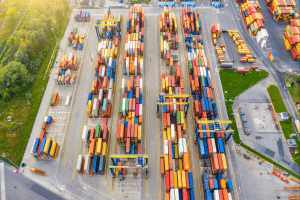Climate change is one of the biggest challenges the world faces – leading to increasing natural hazards and multiplying loss of lives. Extreme weather events also pose a grave threat to infrastructure assets. Our existing infrastructure — that includes, buildings, roads, highways and bridges, airports and railway lines, power stations or telecom towers – is already vulnerable to today’s extreme weather. For instance, in the United States alone, the year 2021 witnessed record-smashing 20 weather disasters that each resulted in at least USD 1 billion in damages, according to NOAA National Centers for Environmental Information.

Or take this State of the Climate in Asia 2021 report from the World Meteorological Organization (WMO) which finds that conomic losses from drought, storms and floods in the continent have gone significantly. In 2021 alone, weather and water-related hazards caused total damage of USD 35.6 billion, affecting nearly 50 million people.
As global warming worsens, which, in probability, it will, the world will experience severe changes in climate patterns in the coming years, including heat waves and freezing winters, rising sea levels and changing rainfall patterns leading to droughts and floods. As the NOAA report illustrates, Climate change will only exacerbate these vulnerabilities. And since infrastructure actually is an interconnected network of all these assets, damages to any of these has a cascading effect on the entire network.
ALSO READ: The World Needs Urgent Climate Action – Now!
Resilient infrastructure calls for smart technologies
In this background, the case for climate-resilient infrastructure becomes compelling. Climate-resilient infrastructure saves both lives and money.
The United Nations Office for Project Services (UNOPS) believes quality infrastructure and improved procurement processes are central to combating climate change and are key to climate mitigation and adaptation efforts.
A research from the MIT Concrete Sustainability Hub found that investments in climate-resilient construction can prevent enough damage to pay for themselves in as little as two years in hazard-prone areas. There are other studies that have concluded that every dollar invested in resilience can save up to USD 11 in repair costs over time.
Digital technologies are set to play a key role in this transformation, but the progress has been slow. For instance, as we earlier noted in a recent article, the United States itself scores low when it comes to technology integration. The American infrastructure sector remains one of the least digitalized ones in the country. One of the most significant reasons for this is the low levels of public investment over the years, which has fallen by more than 40% since the 1960s.
ALSO READ: Rebuilding American Infrastructure
In this context, President Joe Biden’s Bipartisan Infrastructure Law is a transformational opportunity to address America’s crumbling infrastructure through technology uptake, and make an impact against the climate crisis across the country through multiple funding opportunities. The law, also known as the Infrastructure Investment and Jobs Act, sets ambitious climate-focused goals, including reduction in emissions, building community and infrastructure resiliency, and creating clean public transportation systems.
The European Union and UK, and countries like Singapore, China, Australia or the UAE have been early starters in digitalization of construction and infrastructure. In fact, Singapore is a trendsetter in Industry 4.0 Innovations with its flagship project Virtual Singapore, which taps into static and real-time sources for information to create an accurate 3D model which further helps in visualizing the entire city, right down to building interiors.
Interestingly, while the AEC industry in Europe is a global leader in technology adoption, within the region, it is the lowest-ranked economic sector in digital uptake, finds a white papertitled Mega Trends Driving Digital Transformation in Europe’s AEC Industry, released by Geospatial World. It also finds that digitalization in Europe’s AEC industry is driven by the need for sustainability and resiliency in infrastructure projects, not technology innovation, and the “half-hearted attempts” at incorporating new methods and shedding off the traditional practices have begun to impede the European AEC’s spirited future.
Building back smarter and better
Indeed, building back smarter and better will need the bold adoption of digital practices such as BIM and digital twins, connected engineering, and others.
Geospatial Managing Editor Prof Arup Dasgupta notes digital cities represents another aspect of Industrial Revolution 4.0 where people, data, processes and objects form a virtual continuum in a digital representation of the world.
At the same time, futuristic technologies like the Metaverse opens up another level of innovation. Technologies like 3D modeling and digital twins are developments that move towards blending the physical and digital worlds, which is what the Metaverse seeks to do. As technology advances, these tools may improve to become even more lifelike and useful, particularly in case of infrastructure management.
ALSO READ: Metaverse for Building Next-Gen Infrastructure
The Metaverse can help us better connect with the world around us, interact more deeply, and get to the root of issues. When it comes to issues like addressing climate change or building resilient infrastructure, the Metaverse can help model our entire earth and ecosystem and do simulations to understand the impact of various policies on the climate.
Disclaimer: Views Expressed are Author's Own. Geospatial World May or May Not Endorse it








